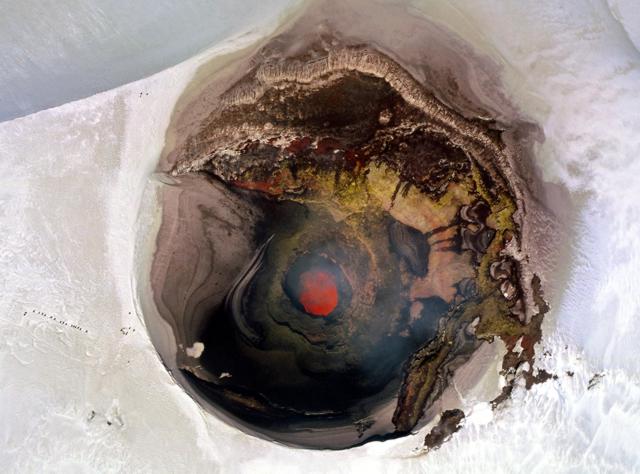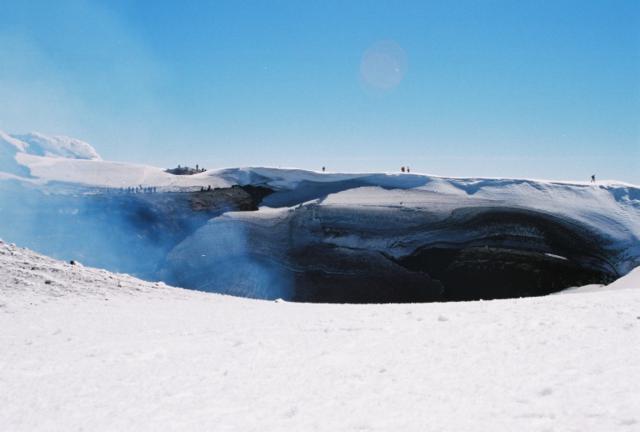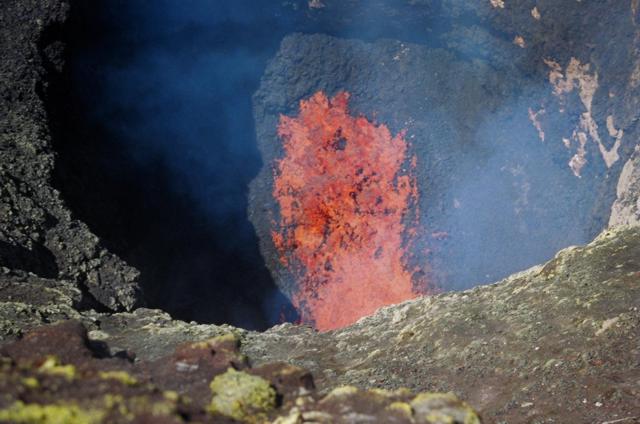Report on Villarrica (Chile) — December 2004
Bulletin of the Global Volcanism Network, vol. 29, no. 12 (December 2004)
Managing Editor: Richard Wunderman.
Villarrica (Chile) Active lava lake observed during late 2004
Please cite this report as:
Global Volcanism Program, 2004. Report on Villarrica (Chile) (Wunderman, R., ed.). Bulletin of the Global Volcanism Network, 29:12. Smithsonian Institution. https://doi.org/10.5479/si.GVP.BGVN200412-357120
Villarrica
Chile
39.42°S, 71.93°W; summit elev. 2847 m
All times are local (unless otherwise noted)
The last report of activity at Villarrica, through May 2002 (BGVN 27:06), described a general decrease in incandescence in the summit crater's lava lake, and noted ballistics ejected in January 2002.
Jacques-Marie Bardintzeff reported that climbers to the top of the volcano on 5 November 2004 noted a strong sulfur smell and observed projections of red lava at a depth of 200-300 m in the crater. On 16 November, a small lava lake was visible in the crater from the air; it was photographed on the 19th (figure 18). Many volcanologists attending the IAVCEI General Assembly at Pucón 14-19 November 2004 ascended and observed activity in the summit crater (figure 19). Although the lava lake itself lay at the bottom of a steep-walled inner crater and was not visible, periodic ejection of large quantities of incandescent lava fragments to a maximum height just above the rim of the inner crater could be seen from a bench below the SW rim of the outer summit crater (figure 20). Bardintzeff noted on 24 November 2004 that a white and blue plume of H2O vapor and SO2, extending to the E from Villarrica, was observed from Pucón. During the night, the plume was red colored. According to the local inhabitants, this was the first observation of a plume since January 2004.
According to the Publicación Oficial del Grupo Projecto de Observación Villarrica (P.O.V.I.) website, incandescence was seen above the summit crater on the nights of 5-6 August and 27-28 October 2004 and frequently during November and December. On the night of 12-13 December Strombolian explosions every 2-5 minutes ejected incandescent spatter and bombs to 100 m height that landed on the outer crater rim. On the 13th the lava lake was ~ 30 m in diameter and at a depth of ~ 100 m. Vigorous convection of the lava lake was punctuated at intervals not exceeding 15 seconds by Strombolian explosions that ejected fine ash, lapilli up to 4 mm in diameter that fell to within a few meters of the inner edge of the crater, and incandescent spatter to the NE to heights of ~ 50 m. By 27 December solidification of ejected spatter around the vent had decreased its diameter by 2/3 with respect to 13 December, and Strombolian explosions at intervals of 2-5 minutes ejected material ~ 100 m above the vent. On 9 and 17 January minor explosions took place at intervals of 1-2 minutes. By 17 January fissures had formed around the N to E sides of the vent, and the opposite side of the vent edge, and the slope above it, had collapsed.
Satellite-based MODIS thermal alerts were first detected at 0345 UTC on 5 November and also occurred on 6, 16, 17, 22, 24, and 29 November, 5, 8, 9, 14, 19, 21, and 31 December, and 1 and 2 January 2005. Prior to 5 November 2004, MODIS thermal alerts not previously reported in this Bulletin had been detected at Villarrica on 23 May, 10 and 17 July, 2, 6, 25, and 27 August, 16 and 28 September, 2, 12, 14, 27, and 30 October, 1, 3, 22, and 28 November 2003, 31 January, 1-3, 7, 10, 12, and 14 February, and 0345 UTC on 26 March 2004 (2345 local time 25 March). According to the P.O.V.I. website, strong explosive activity ejected incandescent pyroclastic material on 28 August 2003, and except for three cloud-covered days, incandescence above the summit crater was seen daily from 27 January to 20 February 2004.
General Reference. Calder, E.S., Harris, A.J.L., Peña, P., Pilger, E., Flynn, L.P., Fuentealba, G., and Moreno, H., 2004, Conbined thermal and seismic analysis of the Villarrica volcano lava lake, Chile: Revista Geológica de Chile, v. 31, no. 2, p. 259-272.
Lara, L.E., and Clavero, J. (eds.), 2004, Villarrica volcano (39.5°S), Southern Andes, Chile: Servicio Nacional de Geología y Minería - Chile, Santiago, Boletin No. 61.
Geological Summary. The glacier-covered Villarrica stratovolcano, in the northern Lakes District of central Chile, is ~15 km south of the city of Pucon. A 2-km-wide caldera that formed about 3,500 years ago is located at the base of the presently active, dominantly basaltic to basaltic andesite cone at the NW margin of a 6-km-wide Pleistocene caldera. More than 30 scoria cones and fissure vents are present on the flanks. Plinian eruptions and pyroclastic flows that have extended up to 20 km from the volcano were produced during the Holocene. Lava flows up to 18 km long have issued from summit and flank vents. Eruptions documented since 1558 CE have consisted largely of mild-to-moderate explosive activity with occasional lava effusion. Glaciers cover 40 km2 of the volcano, and lahars have damaged towns on its flanks.
Information Contacts: Jacques-Marie Bardintzeff, Laboratoire de Pétrographie-Volcanologie, Bât. 504 Université Paris-Sud, F-91405 Orsay, France (URL: http://www.lave-volcans.com/bardintzeff.html); Judy Harden, Department of Geology, University of South Florida, 4202 E. Fowler Ave, SCA528, Tampa, FL 33620, USA; Publicación Oficial del Grupo Projecto de Observación Villarrica - Internet (P.O.V.I.) (URL: http://www.povi.cl/); Jean-Claude Tanguy, Univ. Paris 6 & Institut de Physique du Globe de Paris, Observatoire de St. Maur, 94107 St. Maur des Fossès, France.




